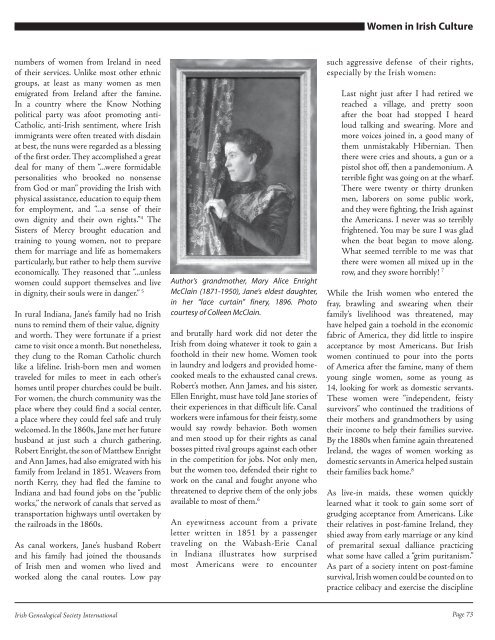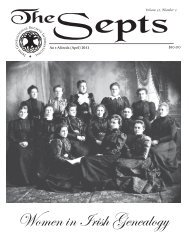(April) 2011 - Irish Genealogical Website International
(April) 2011 - Irish Genealogical Website International
(April) 2011 - Irish Genealogical Website International
You also want an ePaper? Increase the reach of your titles
YUMPU automatically turns print PDFs into web optimized ePapers that Google loves.
________________________________________________________________ Women in <strong>Irish</strong> Culture<br />
numbers of women from Ireland in need<br />
of their services. Unlike most other ethnic<br />
groups, at least as many women as men<br />
emigrated from Ireland after the famine.<br />
In a country where the Know Nothing<br />
political party was afoot promoting anti-<br />
Catholic, anti-<strong>Irish</strong> sentiment, where <strong>Irish</strong><br />
immigrants were often treated with disdain<br />
at best, the nuns were regarded as a blessing<br />
of the first order. They accomplished a great<br />
deal for many of them “...were formidable<br />
personalities who brooked no nonsense<br />
from God or man” providing the <strong>Irish</strong> with<br />
physical assistance, education to equip them<br />
for employment, and “...a sense of their<br />
own dignity and their own rights.” 4 The<br />
Sisters of Mercy brought education and<br />
training to young women, not to prepare<br />
them for marriage and life as homemakers<br />
particularly, but rather to help them survive<br />
economically. They reasoned that “...unless<br />
women could support themselves and live<br />
in dignity, their souls were in danger.” 5<br />
In rural Indiana, Jane’s family had no <strong>Irish</strong><br />
nuns to remind them of their value, dignity<br />
and worth. They were fortunate if a priest<br />
came to visit once a month. But nonetheless,<br />
they clung to the Roman Catholic church<br />
like a lifeline. <strong>Irish</strong>-born men and women<br />
traveled for miles to meet in each other’s<br />
homes until proper churches could be built.<br />
For women, the church community was the<br />
place where they could find a social center,<br />
a place where they could feel safe and truly<br />
welcomed. In the 1860s, Jane met her future<br />
husband at just such a church gathering.<br />
Robert Enright, the son of Matthew Enright<br />
and Ann James, had also emigrated with his<br />
family from Ireland in 1851. Weavers from<br />
north Kerry, they had fled the famine to<br />
Indiana and had found jobs on the “public<br />
works,” the network of canals that served as<br />
transportation highways until overtaken by<br />
the railroads in the 1860s.<br />
As canal workers, Jane’s husband Robert<br />
and his family had joined the thousands<br />
of <strong>Irish</strong> men and women who lived and<br />
worked along the canal routes. Low pay<br />
<strong>Irish</strong> <strong>Genealogical</strong> Society <strong>International</strong><br />
Author’s grandmother, Mary Alice Enright<br />
McClain (1871-1950), Jane’s eldest daughter,<br />
in her “lace curtain” finery, 1896. Photo<br />
courtesy of Colleen McClain.<br />
and brutally hard work did not deter the<br />
<strong>Irish</strong> from doing whatever it took to gain a<br />
foothold in their new home. Women took<br />
in laundry and lodgers and provided homecooked<br />
meals to the exhausted canal crews.<br />
Robert’s mother, Ann James, and his sister,<br />
Ellen Enright, must have told Jane stories of<br />
their experiences in that difficult life. Canal<br />
workers were infamous for their feisty, some<br />
would say rowdy behavior. Both women<br />
and men stood up for their rights as canal<br />
bosses pitted rival groups against each other<br />
in the competition for jobs. Not only men,<br />
but the women too, defended their right to<br />
work on the canal and fought anyone who<br />
threatened to deprive them of the only jobs<br />
available to most of them. 6<br />
An eyewitness account from a private<br />
letter written in 1851 by a passenger<br />
traveling on the Wabash-Erie Canal<br />
in Indiana illustrates how surprised<br />
most Americans were to encounter<br />
such aggressive defense of their rights,<br />
especially by the <strong>Irish</strong> women:<br />
Last night just after I had retired we<br />
reached a village, and pretty soon<br />
after the boat had stopped I heard<br />
loud talking and swearing. More and<br />
more voices joined in, a good many of<br />
them unmistakably Hibernian. Then<br />
there were cries and shouts, a gun or a<br />
pistol shot off, then a pandemonium. A<br />
terrible fight was going on at the wharf.<br />
There were twenty or thirty drunken<br />
men, laborers on some public work,<br />
and they were fighting, the <strong>Irish</strong> against<br />
the Americans. I never was so terribly<br />
frightened. You may be sure I was glad<br />
when the boat began to move along.<br />
What seemed terrible to me was that<br />
there were women all mixed up in the<br />
row, and they swore horribly! 7<br />
While the <strong>Irish</strong> women who entered the<br />
fray, brawling and swearing when their<br />
family’s livelihood was threatened, may<br />
have helped gain a toehold in the economic<br />
fabric of America, they did little to inspire<br />
acceptance by most Americans. But <strong>Irish</strong><br />
women continued to pour into the ports<br />
of America after the famine, many of them<br />
young single women, some as young as<br />
14, looking for work as domestic servants.<br />
These women were “independent, feisty<br />
survivors” who continued the traditions of<br />
their mothers and grandmothers by using<br />
their income to help their families survive.<br />
By the 1880s when famine again threatened<br />
Ireland, the wages of women working as<br />
domestic servants in America helped sustain<br />
their families back home. 8<br />
As live-in maids, these women quickly<br />
learned what it took to gain some sort of<br />
grudging acceptance from Americans. Like<br />
their relatives in post-famine Ireland, they<br />
shied away from early marriage or any kind<br />
of premarital sexual dalliance practicing<br />
what some have called a “grim puritanism.”<br />
As part of a society intent on post-famine<br />
survival, <strong>Irish</strong> women could be counted on to<br />
practice celibacy and exercise the discipline<br />
Page 73




